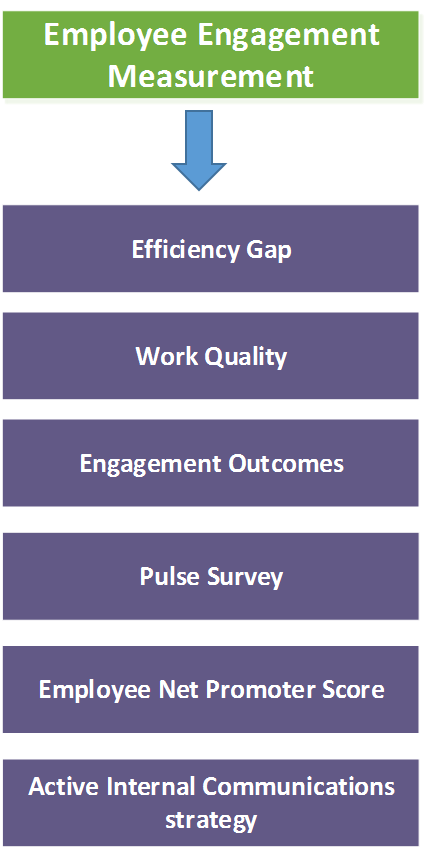Some most important ways to measure employee’s engagement are as follows:

Efficiency Gap: Efficiency gap is one of the most important methods which are used to estimate employee’s engagement. Employee Who are dedicated, able to Ineet target on time and possess good relation with colleague are engaged employees and are also asset to the organisation. To measure employee’s engagelnent, organisation uses attendance records. assessment of team performance, and use of organisational resources by the employee. But while measuring it, employer has to maintain a balance between being a manager and being a boss.
Work Quality: When employees are having high degree of engagement then results produced by them will be Of better quality. Hence, employer must keep informing their employees that work done by them is crucial and must be Of standard quality. Therefore, in order to estimate employee engagement. the rejection of work and incomplete task acts as important criteria.
Engagement Outcomes: It is an outcome of survey conducted by the organisation among the employees with an aim to identify sentiments of employees toward organisation. Hence, this outcome helps organisation to identify the employee engagement at work. For example, engagement outcomes show that whether employee is emotionally connected with organisation and will recommend Others to join it. This does not reflect any particular action but it will explain the level of engagement of employees toward organisation.
Pulse Survey: Most of the employees consider survey conducted by organisation as a waste of time and useless activity which distracts worker from their work. Whereas, pulse survey mark itself different by restricting the number of questions to five. Questions asked in this Survey are easy and simple where employees will only have to rate their response on the basis of their satisfaction. Organisation must regularly conduct this pulse survey, it helps organisation to figure out employees emotion at different point of time.
Employee Net Promoter Score: This technique is used to determine employee’s emotional attachments with the organisation where they work. It determines employee’s satisfaction through a survey where employer wants to know ‘how likely employee will prefer to recommend their relatives and friend to work in this organisation’. Here, employee will have to answer this question through assigning a number out of 10 as per their satisfaction. Further, organisation divides this survey result in two categories of 0-6 and 9-10. Employees falling in category of 0-6 are the termed as criticisers and employees in category of 9-10 are termed as promoters. Therefore, in order to know the employee net promoter score, organisation subtracts the score of criticisers from the score of promoters. Before sending the result to employees, organisation must present the result of this employee net promoter scale in the form of schedule.
Active Internal Communications strategy: In order to promote communication with employees, organisation can either incorporate regular internal communication or an effective intranet. This communication can also be used for e-forums, seek response on article and videos and receive feedback of organisation new policies and changes. Different employee engagement measurement tools are used in this content, like intelligent analytics which provides a clear view to organisation about employee’s response on specific policy or initiative of organisation. Measuring employee engagement is not an end in itself. It delivers results which can be used by the organisation in order to improve and strengthen their culture and authority of employees. Whereas simply collecting information through employee engagement can be dangerous because employee may feel that their feedback were not given any importance.